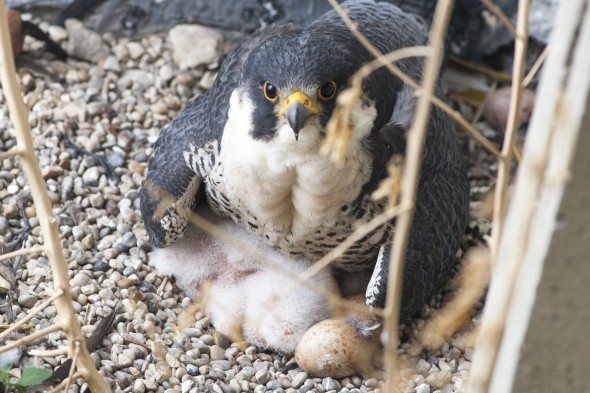Falcons return to hatch two chicks in nest on UH ledge

Two falcon chicks hatched last week outside the 28th floor of University Hall. Photo: Roberta Dupuis-Devlin
Robert Easter officially retired from his position as university president Sunday, but he will be back on campus June 5 for a special honor: the banding of a baby falcon named Bob in his honor.
The other baby falcon that hatched on the ledge of University Hall last week will be named Cheryl, in honor of Easter’s wife.
A ledge on the 28th floor has been home to a new family of peregrine falcons each spring for nearly 30 years. Watch the newest falcon family live on the UIC FalconCam.
For the last two years, falcons Nitz and Mouse have raised chicks on the ledge. It’s likely they are the parents of the new brood, but that must be confirmed at the banding, said Field Museum expert Mary Hennen.
“For the most part, pairs stay together but there could be change-over if one gets old and dies or one loses out,” said Hennen, director of the Chicago Peregrine Program. “In general, if something happens to one, the other will get a new mate.”
Two chicks hatched last week and the birds are still sitting on one egg. Another unhatched egg was pushed to the side.
“That egg is probably rotten,” Hennen said. “For whatever reason, it wasn’t fertile. The birds generally lay one egg every 24 to 28 hours. The first one has the least amount of incubation. It could have been out in the cold.”
The peregrine pair made its nest at University Hall in April. The female bird sits on eggs about 30 days before they hatch, Hennen said.
There are 19 known breeding pairs of peregrine falcons in Illinois; 24 chicks have hatched so far this spring. Birds tend to return to the same nesting spots each year, Hennen said.
“They look for ledges that are protected from winds and have enough of a prey base to support the family,” she said.
The birds are banded when they are between 21 and 24 days old — full sized but not ready to fly, Hennen said. They usually take their first flight when they are about 40 days old.
“We don’t want them to be so big and active that they see you and try to fly away,” she said. “The banding allows us to track them for longevity and dispersal. It’s harder to identify them by looking at them.”
Hennen has been banding birds at UIC since 1996. The Chicago Peregrine Release program placed the first chicks atop University Hall in 1986.
